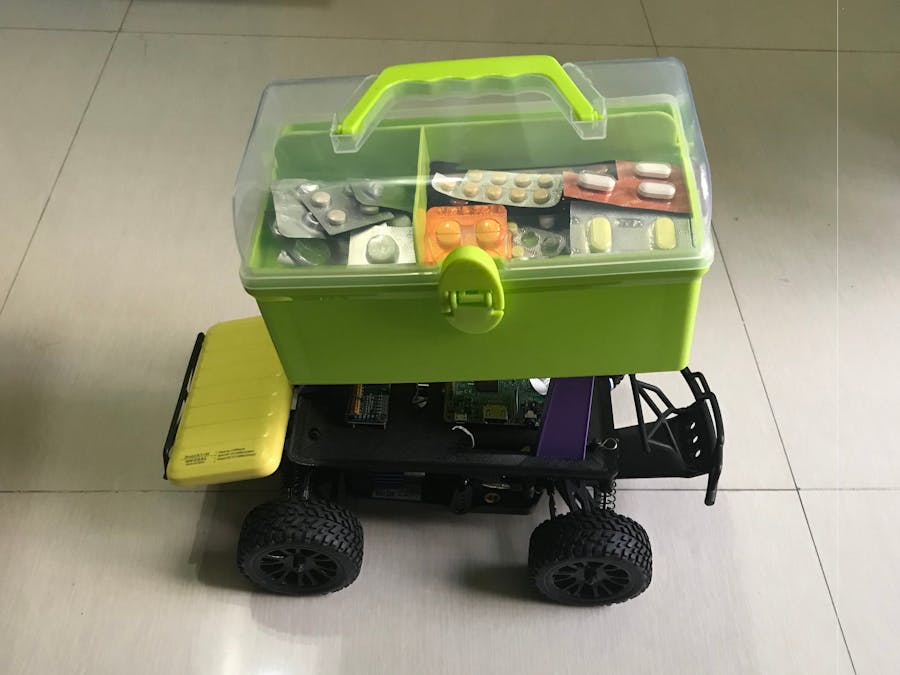#!/usr/bin/env python3
"""
Scripts to drive a donkey 2 car and train a model for it.
Usage:
manage.py (drive) [--model=<model>] [--js]
manage.py (train) [--tub=<tub1,tub2,..tubn>] (--model=<model>) [--no_cache]
Options:
-h --help Show this screen.
--js Use physical joystick.
--fix Remove records which cause problems.
--no_cache During training, load image repeatedly on each epoch
"""
import os
from docopt import docopt
import donkeycar as dk
#import parts
from donkeycar.parts.camera import PiCamera
from donkeycar.parts.transform import Lambda
from donkeycar.parts.keras import KerasCategorical
from donkeycar.parts.actuator import PCA9685, PWMSteering, PWMThrottle
from donkeycar.parts.datastore import TubHandler, TubGroup
from donkeycar.parts.controller import LocalWebController, JoystickController
from donkeycar.parts.hcsr04 import hcsr04 #hcsr04-custom ultra-sonic sensor part
def drive(cfg, model_path=None, use_joystick=False):
'''
Construct a working robotic vehicle from many parts.
Each part runs as a job in the Vehicle loop, calling either
it's run or run_threaded method depending on the constructor flag `threaded`.
All parts are updated one after another at the framerate given in
cfg.DRIVE_LOOP_HZ assuming each part finishes processing in a timely manner.
Parts may have named outputs and inputs. The framework handles passing named outputs
to parts requesting the same named input.
'''
#Initialize car
V = dk.vehicle.Vehicle()
sonar = hcsr04() #hcsr04-instantiate class object
cam = PiCamera(resolution=cfg.CAMERA_RESOLUTION)
V.add(cam, outputs=['cam/image_array'], threaded=True)
if use_joystick or cfg.USE_JOYSTICK_AS_DEFAULT:
#modify max_throttle closer to 1.0 to have more power
#modify steering_scale lower than 1.0 to have less responsive steering
ctr = JoystickController(max_throttle=cfg.JOYSTICK_MAX_THROTTLE,
steering_scale=cfg.JOYSTICK_STEERING_SCALE,
auto_record_on_throttle=cfg.AUTO_RECORD_ON_THROTTLE)
else:
#This web controller will create a web server that is capable
#of managing steering, throttle, and modes, and more.
ctr = LocalWebController()
V.add(ctr,
inputs=['cam/image_array'],
outputs=['user/angle', 'user/throttle', 'user/mode', 'recording'],
threaded=True)
#See if we should even run the pilot module.
#This is only needed because the part run_condition only accepts boolean
def pilot_condition(mode):
if mode == 'user':
return False
else:
return True
pilot_condition_part = Lambda(pilot_condition)
V.add(pilot_condition_part, inputs=['user/mode'], outputs=['run_pilot'])
#Run the pilot if the mode is not user.
kl = KerasCategorical()
if model_path:
kl.load(model_path)
V.add(kl, inputs=['cam/image_array'],
outputs=['pilot/angle', 'pilot/throttle'],
run_condition='run_pilot')
#V.add(sonar, outputs=['dist'], threaded=True) #hcsr04-custom ultra-sonic sensor part (threaded)
V.add(sonar, outputs=['dist']) #hcsr04-custom ultra-sonic sensor part (non-threaded)
#Choose what inputs should change the car.
def drive_mode(mode,
user_angle, user_throttle,
pilot_angle, pilot_throttle, dist):
if dist < 50: #hcsr04-override throttle to 0 if obstacle distance < 50cm
#print("Stop!")
user_throttle = 0
pilot_throttle = 0
if mode == 'user':
return user_angle, user_throttle
elif mode == 'local_angle':
return pilot_angle, user_throttle
else:
return pilot_angle, pilot_throttle
drive_mode_part = Lambda(drive_mode)
V.add(drive_mode_part,
inputs=['user/mode', 'user/angle', 'user/throttle',
'pilot/angle', 'pilot/throttle', 'dist'], #hcsr04-add dist input
outputs=['angle', 'throttle'])
steering_controller = PCA9685(cfg.STEERING_CHANNEL)
steering = PWMSteering(controller=steering_controller,
left_pulse=cfg.STEERING_LEFT_PWM,
right_pulse=cfg.STEERING_RIGHT_PWM)
throttle_controller = PCA9685(cfg.THROTTLE_CHANNEL)
throttle = PWMThrottle(controller=throttle_controller,
max_pulse=cfg.THROTTLE_FORWARD_PWM,
zero_pulse=cfg.THROTTLE_STOPPED_PWM,
min_pulse=cfg.THROTTLE_REVERSE_PWM)
V.add(steering, inputs=['angle'])
V.add(throttle, inputs=['throttle'])
#add tub to save data
inputs=['cam/image_array', 'user/angle', 'user/throttle', 'user/mode']
types=['image_array', 'float', 'float', 'str']
th = TubHandler(path=cfg.DATA_PATH)
tub = th.new_tub_writer(inputs=inputs, types=types)
V.add(tub, inputs=inputs, run_condition='recording')
#run the vehicle for 20 seconds
V.start(rate_hz=cfg.DRIVE_LOOP_HZ,
max_loop_count=cfg.MAX_LOOPS)
print("You can now go to <your pi ip address>:8887 to drive your car.")
def train(cfg, tub_names, model_name):
'''
use the specified data in tub_names to train an artifical neural network
saves the output trained model as model_name
'''
X_keys = ['cam/image_array']
y_keys = ['user/angle', 'user/throttle']
def rt(record):
record['user/angle'] = dk.utils.linear_bin(record['user/angle'])
return record
kl = KerasCategorical()
tubgroup = TubGroup(tub_names)
train_gen, val_gen = tubgroup.get_train_val_gen(X_keys, y_keys, record_transform=rt,
batch_size=cfg.BATCH_SIZE,
train_frac=cfg.TRAIN_TEST_SPLIT)
model_path = os.path.expanduser(model_name)
total_records = len(tubgroup.df)
total_train = int(total_records * cfg.TRAIN_TEST_SPLIT)
total_val = total_records - total_train
print('train: %d, validation: %d' % (total_train, total_val))
steps_per_epoch = total_train // cfg.BATCH_SIZE
print('steps_per_epoch', steps_per_epoch)
kl.train(train_gen,
val_gen,
saved_model_path=model_path,
steps=steps_per_epoch,
train_split=cfg.TRAIN_TEST_SPLIT)
if __name__ == '__main__':
args = docopt(__doc__)
cfg = dk.load_config()
if args['drive']:
drive(cfg, model_path = args['--model'], use_joystick=args['--js'])
elif args['calibrate']:
calibrate()
elif args['train']:
tub = args['--tub']
model = args['--model']
cache = not args['--no_cache']
train(cfg, tub, model)
elif args['check']:
tub = args['--tub']
fix = args['--fix']
check(cfg, tub, fix)
elif args['histogram']:
tub = args['--tub']
rec = args['--rec']
histogram(cfg, tub, rec)
elif args['plot_predictions']:
tub = args['--tub']
model = args['--model']
plot_predictions(cfg, tub, model)












Comments